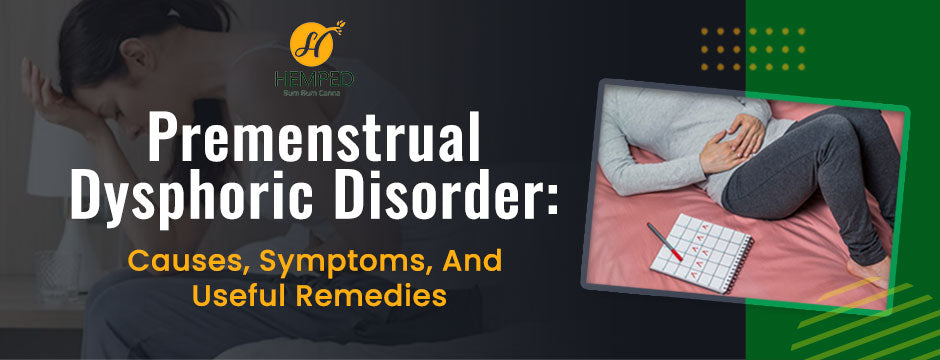
Premenstrual Dysphoric Disorder: Causes, Symptoms, And Useful Remedies
Premenstrual Dysphoric Disorder (PMDD) is a painful condition that experiences severe depressive symptoms, irritability, and tension. Compared to premenstrual syndrome, PMDD symptoms are more severe than PMS symptoms. PMS, or premenstrual syndrome, refers to various physiological or psychological symptoms that most frequently appear 5 to 11 days before a woman's monthly menstrual cycle begins. Most of the time, the symptoms disappear right before or after the start of menstruation. Women of childbearing age are typically affected by PMDD, a serious and persistent medical illness requiring attention and treatment. You can occasionally control PMDD's unpleasant symptoms with medication and lifestyle modifications.
Table of Contents
Common Premenstrual Dysphoric Disorder Causes and Risk Factors
Although the precise aetiology of PMDD is unknown, it may be an aberrant response to the regular hormone changes that occur with each menstrual cycle. Serotonin, a chemical produced naturally in the brain and intestines that can impact mood and create physical symptoms, might become deficient due to hormonal changes. Serotonin is used by specific brain cells to regulate mood, focus, sleep, and pain. Serotonin levels may drop due to hormonal shifts, which could result in PMDD symptoms. Up to 5% of women of childbearing age get PMDD. In addition to PMDD, many women also experience anxiety or despair.
Seasonal affective disorder (SAD) and severe depression are two major disorders that might occasionally be seen along with PMDD. Additional factors have been connected to the symptoms of PMDD. These include but are not limited to, thyroid issues, being overweight, hereditary predispositions, genetic variables, and inactivity.
PMDD Symptoms & Diagnosis
PMDD symptoms typically manifest a week before your period starts and continue through the first few days of your cycle. You may prevent yourself from engaging in daily tasks since they are frequently intense and draining.
PMDD symptoms include:
- Swings in mood, despair, or a sense of helplessness
- Chronic stress and anxiety
- Loss of interest in hobbies and other activities
- Difficulty concentrating
- Brain fog and exhaustion
- Appetite changes
- Insomnia and erratic sleep patterns
- Bloating and cramps
- Breast sensitivity
- Headaches
- Muscle or joint pain
- Hot flashes
While there are no specific physical signs or tests to identify PMDD conclusively, your doctor may diagnose a certain symptom as PMS if it coincides with your regular premenstrual cycle. Your doctor might ask you to log your signs and symptoms for at least two menstrual cycles to build a premenstrual pattern. Both the day they appear, and the day they stop occurring should be noted. Chronic fatigue syndrome, thyroid issues, and mood disorders like anxiety and depression are a few illnesses that might mimic PMS and PMDD. To help make a precise diagnosis, your doctor may request tests like a thyroid function test, a vitamin D and B12 tests, among others.
Remedies For Managing Premenstrual Dysphoric Disorder
PMDD can also cause depression-like symptoms. Some might even disrupt daily life as usual. If someone suffers any depressive symptoms that seem to come and go over the typical menstrual cycle, it is important to discuss them with a doctor or healthcare practitioner. Attempt to keep track of any new symptoms that appear over the month. Knowing this can help determine whether the symptoms and the menstrual cycle are related. More exercise and other lifestyle modifications could be helpful; some drugs may also help with the symptoms.
Dietary Changes
You can control the symptoms of PMS by eating a balanced diet. Changes in nutrition are likely to help with PMDD symptoms like anxiety and bloating. Eat regular meals and snacks to maintain steady blood sugar levels throughout the day. Water consumption in large amounts will also aid in lessening bloating. Taking dietary supplements can be beneficial if it is impossible to obtain the recommended amounts of vitamins, minerals, and other nutrients through food alone. Taking supplements like calcium, vitamin E, magnesium, fish oil, and even CBD oil may help women with premenstrual symptoms. Many women swear by the effectiveness of taking CBD for period cramps and other PMS symptoms. Before utilising supplements for PMDD or other diseases, people should always consult their doctor, especially if they are already on medication or have another medical issue.
Exercise regularly
According to research, regular exercise can help with premenstrual symptoms. According to one study, those who exercise during PMS regularly have less pain and a better mood. Mix strength training with aerobic exercise each week for the best results. Aim for a combination of moderate aerobic activity and strength-training exercises to target all the major muscle groups. Since PMDD is a mood condition, some people may find it difficult to exercise because they lack motivation. The best thing you can do in these circumstances is to take a quick, simple walk. This low-intensity aerobic activity will prepare your lungs for later in your cycle. These will also make you feel better and help you lose weight. These mild activities will increase your body's endorphin release and help to alleviate PMDD symptoms.
Good Sleep is key
Lack of sleep can cause depression, exhaustion, and heightened pain sensitivity. Aim for at least 7 to 9 hours of sleep each night to lessen PMDD symptoms. Getting up and going to bed simultaneously each day is beneficial. Avoid taking long naps during the day and eating or drinking anything with a lot of sugar or caffeine right before bed. Limiting alcohol consumption and shutting off all electronics at least an hour before night are further helpful precautions. It can be beneficial to have a bedtime ritual. Before bed, take a warm bath, listen to calming music, or read a book. See a doctor if sleeping problems like insomnia or sleep apnea prevent you from falling asleep.
CBD Can Help
The major objective of PMDD treatment is to lessen the severe symptoms that are felt two to three weeks before a menstrual cycle. Selective serotonin reuptake inhibitors, or SSRIs, are the most used treatment for PMDD. Some of the emotional side effects that PMDD may bring may be lessened by taking an SSRI, an antidepressant. One of the available treatments is hormone therapy, such as using birth control pills. A healthy diet modification that eliminates sugar, salt, alcohol, and caffeine while increasing proteins and carbohydrates may also assist with symptoms, according to specialists, in addition to these two pharmacological therapy alternatives.
However, SSRI side effects can affect a person's daily life more than only PMDD. Therefore, in addition to diet, exercise, and vitamin supplements, other options are available for those who do not wish to take prescription medications to address the symptoms of PMDD. CBD may be a secure and healthy substitute for SSRIs or other antidepressants. The endocannabinoid system in our bodies has receptors that cannabidiol, or CBD, interacts with. Numerous endocannabinoid receptors regulate fear and anxiety-induced behaviours in the brain. You may reduce some PMDD symptoms by taking CBD for about two weeks before menstruation. Inflammation, stress, and anxiety may all be reduced by CBD, which may diminish irritability and mood swings. A healthier sleep pattern and the potential assistance of CBD with insomnia might lessen fatigue and the sense of being overburdened. For women with PMDD, using CBD with a balanced lifestyle that includes frequent exercise and eating right could be beneficial. If you are new to CBD, look no further than Neet CBD. Neet offers the best quality CBD oil for sale in India.
IS CBD safe for women?
The short answer is that CBD appears to be safe for most people. However, there is no proof that CBD is safe for immunocompromised, pregnant, or nursing mothers. The adverse effects of CBD include tiredness, dry mouth, diarrhoea, and decreased appetite. Before using CBD, please consult your physician or another healthcare professional to determine whether it would be safe and beneficial. You must only purchase CBD from reputable vendors, even though it is fairly easy to find CBD oil for sale in India. Neet CBD is derived from 100% organic and effective, and can effectively alleviate PMDD symptoms.

Conclusion
PMDD is an endocrine disorder and is often difficult to deal with for many people. In addition to physical symptoms, persons with PMDD may encounter various mental health issues, such as anxiety, mood swings, and depression. Due to these factors, it is recognised as a mental health issue in the DSM-5, one of the primary manuals used by psychiatrists to classify and identify mental health issues. A person's capacity to function and quality of life may be affected by PMDD. You can treat PMDD with lifestyle adjustments, natural treatments, or pharmaceuticals.
In the end, it's crucial to remember that you are ultimately responsible for how you interpret your symptoms and experiences. To manage the consequences of PMDD on your life, you must receive the support you need and deserve. Some people might require a mix of all three choices in addition to supplements like CBD for period cramps and other symptoms. Once they have discovered the best medication or combination of treatments, most women experience an improvement in symptoms.
